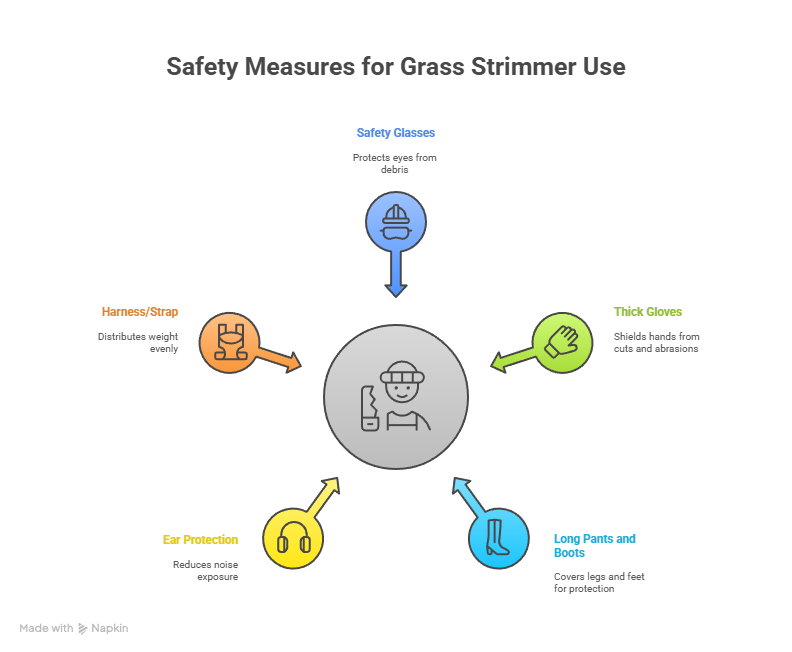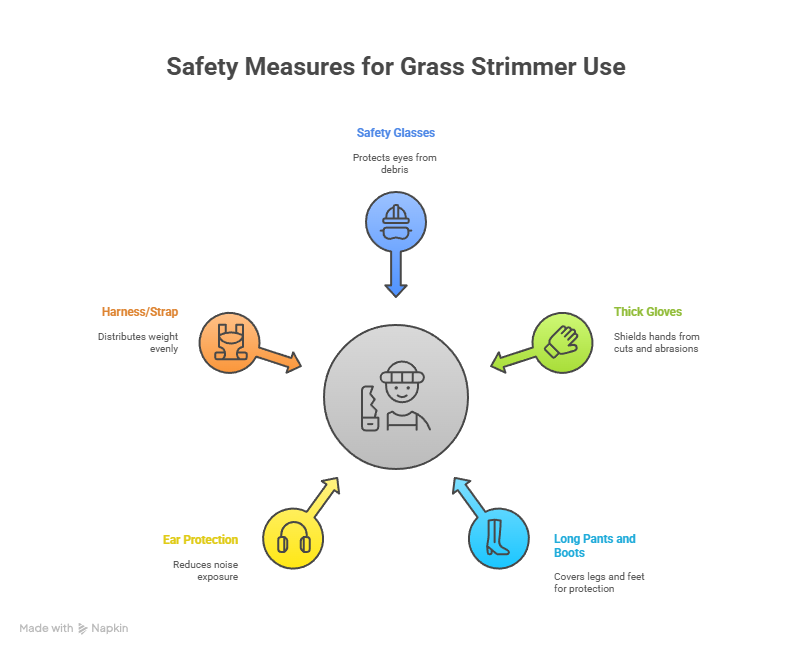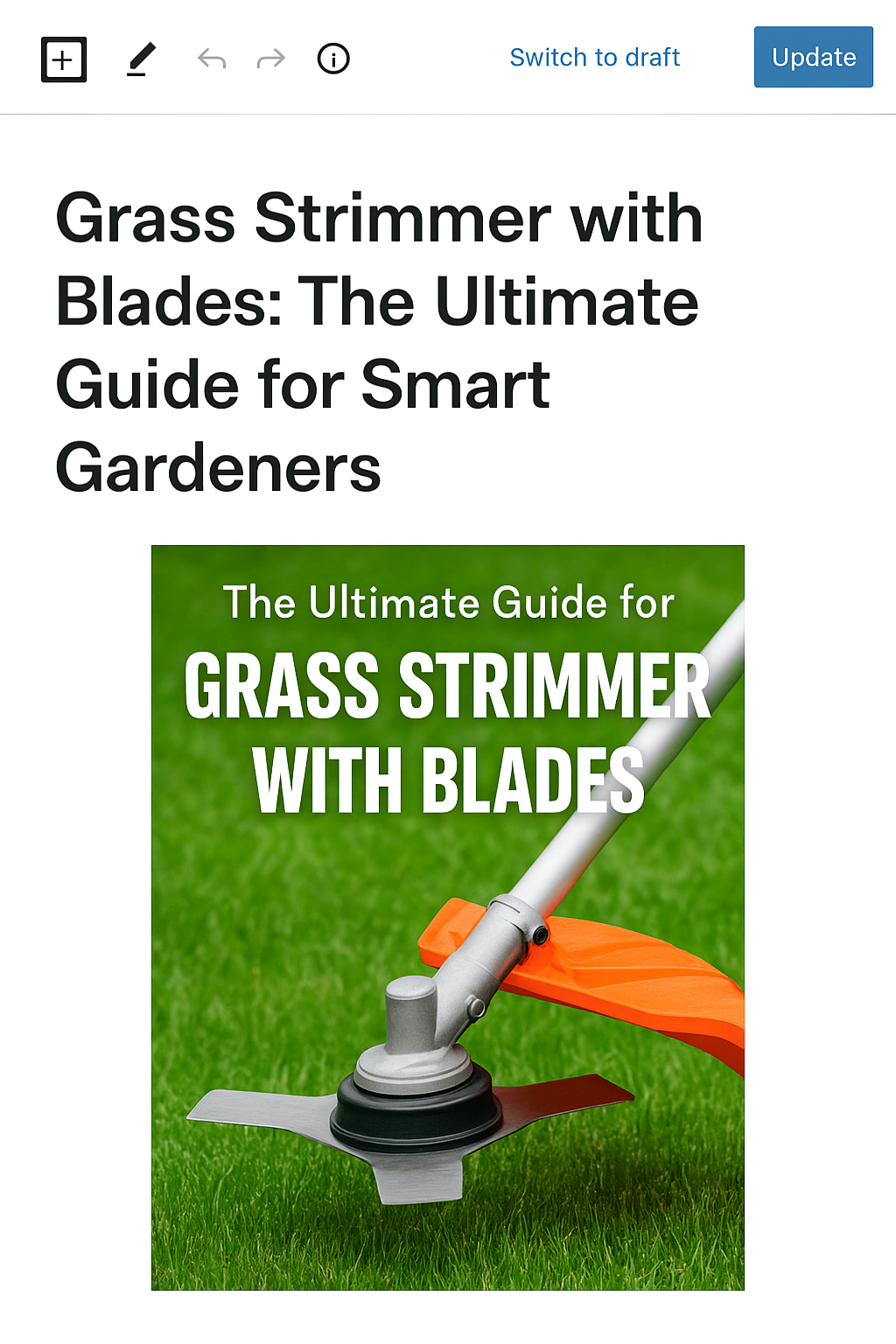Whether you’re a weekend gardener or a professional landscaper, one tool stands out when you need to tackle thick weeds, brambles, or overgrown edges: the grass strimmer with blades. While traditional string trimmers work well for light trimming, bladed strimmers are in a league of their own when it comes to power and precision.
In this comprehensive guide, we’ll explore everything you need to know about bladed grass strimmers—from what they are and how they work, to the types of blades available, how to use them safely, and how to choose the best one for your needs.

What is a Grass Strimmer with Blades?
A grass strimmer with blades is a versatile gardening power tool designed to cut through dense vegetation using sharp metal or plastic blades instead of nylon string. It’s an upgraded alternative to the standard string trimmer, especially useful for:
- Thick grass and weeds
- Tough brush and undergrowth
- Woody stems or brambles
- Edging along fences and walls
These tools are often referred to as brush cutters, although some grass trimmers have interchangeable heads that allow you to swap between string and blades.
Why Choose a Bladed Strimmer Over a String Trimmer?
Here’s why more gardeners and landscapers are opting for blade-equipped models:
✅ More Cutting Power
Metal blades slice through heavy growth that would wrap around or break nylon string. They’re ideal for untamed areas.
✅ Longer Lasting Performance
Blades don’t wear down as quickly as string. You don’t need to stop mid-job to reload.
✅ Versatile Applications
While string is great for delicate lawns, blades can tackle brush, vines, and even small saplings.
✅ Efficient in Large or Wild Areas
If you maintain larger plots, orchards, or overgrown areas, a bladed trimmer saves you both time and energy.

Types of Blades for Grass Strimmers
Not all blades are created equal. Here’s a look at the main types:
1. Metal Blades
- Material: Steel or alloy
- Use: Heavy-duty tasks like cutting thick grass, shrubs, or saplings
- Variants:
- 3-tooth blade: Good for grass and light brush
- 8-tooth or 40-tooth saw blades: Suitable for woody shrubs and stems
2. Plastic Blades
- Material: Hardened plastic
- Use: Light to medium trimming—denser than string but less risky than metal
- Pros: Safer, easier to replace, great for casual gardeners
3. Tri-Arc Blades
- Triangular or curved, these blades provide better balance and maneuverability.
4. Multi-Tooth Blades
- Resemble circular saws and are used for extreme brush clearing.
🛠️ Pro Tip: Always match your blade to your job. Using a metal saw blade for light grass is overkill and can be dangerous.
Types of Grass Strimmers That Support Blades
Grass strimmers come in different forms, but only some models are compatible with blade attachments. Let’s go over the main types:
✦ Electric Grass Strimmers (Corded)
- Power: Moderate
- Best for: Small gardens
- Blade Support: Rare—mostly string only
✦ Battery-Powered (Cordless) Strimmers
- Power: Moderate to high (depending on voltage)
- Blade Support: Some advanced models support plastic or metal blades
- Best for: Residential use
✦ Petrol/Gas-Powered Strimmers
- Power: High
- Blade Support: Yes—commonly used with metal blades
- Best for: Heavy-duty commercial or rural work
✦ Multi-Function Strimmers / Brush Cutter Combos
- Interchangeable heads make these tools adaptable for string trimming, blade cutting, and even hedge trimming.
Best Use Cases for Blade Strimmers
You’ll get the most value from a blade-equipped trimmer in these situations:
| Situation | Why It Works |
|---|---|
| Overgrown gardens | Cuts through thick growth efficiently |
| Farm edges & orchards | Handles weeds, vines, and saplings |
| Pathway & fence lines | Blades get close to hard edges |
| Ditches & slopes | Strong blades power through tough spots |
| Bramble & brush areas | Nylon would snap, blades slice clean |
How to Use a Grass Strimmer with Blades Safely
Blade trimmers offer power—but that power comes with responsibility.
🦺 Safety Gear Checklist:
- Safety glasses or face shield
- Thick gloves
- Long pants and boots
- Ear protection (for gas-powered models)
- Harness or shoulder strap for weight distribution
⚙️ Operating Tips:
- Inspect the blade before each use. Tighten bolts.
- Hold with two hands for better control.
- Use smooth, sweeping motions—let the blade do the work.
- Avoid hard objects like rocks and metal poles.
- Stop the engine before inspecting or changing the blade.
🛑 Warning: Never use a metal blade without a proper guard installed!
Maintenance Tips for Blade Strimmers
A well-maintained blade strimmer performs better and lasts longer.
🔧 After Each Use:
- Clean the blade and underside to remove grass build-up.
- Check the blade for dullness, cracks, or chips.
🔁 Weekly/Monthly:
- Sharpen metal blades using a file or grinder.
- Lubricate moving parts if recommended by the manufacturer.
- Inspect fuel lines and spark plugs (for petrol models).
- Recharge or replace batteries as needed (cordless models).
🛠 Blade Replacement:
- Most blades are easily replaceable with a wrench or quick-release system.
- Always follow the user manual’s torque recommendations.
Top 5 Grass Strimmers with Blades (2025)
Here are some highly rated models currently on the market that support blades:
| Brand/Model | Power Source | Blade Type | Best For |
|---|---|---|---|
| Husqvarna 129R | Petrol | 3-tooth metal | Heavy-duty use |
| STIHL FS 91 | Petrol | Multi-tooth | Professionals |
| DEWALT DCST922B | Battery | Plastic | Homeowners |
| Makita XRU23Z | Battery | Metal/Plastic | General use |
| Ryobi RY4CCS | Petrol | Metal | Affordable all-rounder |
📌 Tip: Look for models with an included shoulder harness—they make long trimming sessions more comfortable.
Pros and Cons of Using Bladed Grass Trimmers
✅ Pros:
- Cuts thick vegetation with ease
- Durable, long-lasting blades
- Ideal for hard-to-reach places
- Reduces job time significantly
- Compatible with various blade types
❌ Cons:
- Heavier than string-only trimmers
- Requires more safety precautions
- May damage fencing or garden ornaments
- Metal blades can be dangerous if mishandled
- Costlier than standard models
FAQs About Grass Strimmers with Blades
🔹 Can I convert my string trimmer to a bladed one?
Yes, but only if your model supports it. Check your manual for blade compatibility. Never modify a unit without manufacturer guidance.
🔹 Are bladed strimmers safe for edging lawns?
Plastic blades—yes. Metal blades—use with caution. They’re better suited for rugged trimming, not delicate lawn edges.
🔹 How often should I sharpen my blade?
It depends on usage. For regular work, sharpen every 4–6 uses. Dull blades strain the motor and cut poorly.
🔹 What size blade should I use?
Most models support 8–10 inch blades, but always match blade size to your tool’s specifications.
Final Thoughts: Should You Buy a Grass Strimmer with Blades?
If your yard is more jungle than putting green, a grass strimmer with blades is a game-changer. These tools offer unmatched power, durability, and performance when faced with tough outdoor jobs. From taming brambles to slicing through dense grass, blade-equipped trimmers give you the edge—literally.
Before buying, think about your lawn size, type of vegetation, and how often you’ll use the tool. Whether you’re a casual gardener or a landscaping pro, there’s a perfect blade trimmer out there waiting to make your yard work easier, faster, and more efficient.

